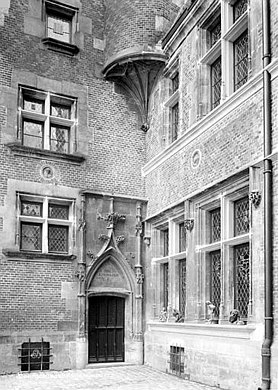Hotel Cujas
The Hôtel Cujas is a city palace in the central French city of Bourges . It is named after the lawyer Jacques Cujas , who bought it and lived in it during his stay in Bourges. It has housed the Musée de Berry since 1878 and contains archaeological and medieval collections as well as paintings from the 15th to 19th centuries. Valuable alabaster statues from the 15th century, including those of Jean de Valois , Duke of the Berry Province , complete the museum artifacts.
Building
The atypical building, which was erected between 1508 and 1515, is in the Gothic tradition both in terms of its floor plan and the choice of building materials , but details such as medallions , dormer windows and entrance door already point to the French Renaissance . It is located on Rue des Arènes 2 on the north-western edge of the old town.
The style is characterized by the use of red and black bricks arranged in a diamond shape, as well as limestone . This limestone Pierre de Charly ou de Blet comes from the quarry of the two communities of the same name, Charly and Blet , located about 35 km southeast , which is still in operation today. The high and durable quality of the building material makes it indispensable for repair and improvement work on numerous historical buildings. The marble medallions that can be seen in the inner courtyard and the rocailles-like decorations on the dormer windows are now interpreted as a concession to the Italian taste of the time. This elaborate decoration continues inside the building.
Lattice windows , roof turrets , gargoyles , etc. are richly decorated, floral forge or sheet metal work. The chimneys are high quality stone carvings.
owner
The building was built in the early 16th century for the Florentine merchant Durant Salvi , who ran high-quality cloth trading - also to the royal family. Today the building is mostly attributed to the architect Guillaume Pellevoysin (1477–1534). In 1585 Jacques Cujas acquired this property, who had been in Bourges since 1555, stayed in Valence for a year in 1558 and only moved here five years before his death.
The Ursuline Order later moved in here and after its dissolution at the end of the French Revolution it came back into private hands. In 1829 the city of Bourges bought it as the seat of the gendarmerie and since 1878 it has been a cultural center. It has been owned by the municipality ever since. In 1862 it was declared a cultural monument.
Fresco over a fireplace
Web links
literature
- Josiane Sartre: Châteaux ‹brique et pierre› en France: Essai d'architecture . Nouvelles Editions Latines 1981, ISBN 978-2723-30135-0
Individual evidence
- ^ Hôtel Cujas City of Bourges, Cultural Heritage (French)
- ↑ David Dess Andier: Mémento des pierres du patrimoine bâti de la région Center . Bureau de recherches géologiques et minières , March 2003, page 65
- ↑ a b Le Musee du Berry a Bourges . L'Encyclopedie de Bourges (French)
- ↑ Epi de faîtage en plomb . Example of a roof decoration, Ministry of Culture
- ↑ Chéminée: Motif décoratif en pierre . Example of a roof decoration, Ministry of Culture
- ↑ Leo Palustre: L'Architecture de la Renaissance . Collection XIX, 2015, page 222
- ^ Hôtel Cujas, actuel musée du Berry Cultural assets of the Cher department (French)
- ^ Hôtel Cujas, ou Salvi . Ministère de la Culture, September 14, 1993
Coordinates: 47 ° 5 '8 " N , 2 ° 23' 36" E




